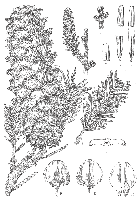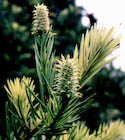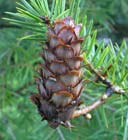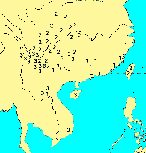Keteleeria davidiana
(Bertrand) Beissner 1891
Common names
铁坚油杉 tie jian shan [Chinese]; ユサン [Japanese].
Taxonomic notes
Syn: Pseudotsuga davidiana Bertrand 1872; Pinus davidiana (Bertrand) McNab 1876; A. sacra Franchet 1884; Abies davidiana (Bertrand) Franch. 1884; K. sacra (Franch.) Beissner 1891; Podocarpus sutchuenensis Franchet 1899; Pinus sacra (Franch.) Voss 1907; K. esquirolii Léveillé 1910; K. chienpeii Flous 1936; K. calcarea Cheng & Fu 1975; K. pubescens Cheng & Fu 1975; K. xerophila Xue & Hao 1981 (Dallimore et al. 1967, Cheng & Fu 1978, Farjon 1998). Many of these specifics have also been applied as subspecific or varietal epithets; see Farjon (1998) for full synonymy. One described variety, formosana (syn: K. formosana Hayata 1908), is disjunct from the mainland populations but shows little morphological differentiation.
Description
A tree to 40 m tall and 200 cm dbh, resembling a silver fir when young but eventually assuming an irregular habit with massive branches and large, buttress-like roots spreading from the base of the bole. Bark dull brown to grayish black, irregularly shaky, and somewhat scaly, scales about 4 mm. thick; lenticels inconspicuous; outer bark about 1.3 cm. thick, in tiers, with alternate layers of grayish white or pale yellowish red corky layer and grayish brown or reddish brown fibrous layer; newly formed periderm inconspicuous; inner bark 0.8-1.0 cm. thick, pale brown, fibrous, with densely scattered, dark brown stone-cell groups, more or less mucous; cambium and newly formed phloem inconspicuous. Freshly cut sapwood pale yellowish red or pale apricot yellow, wood rays thready. Buds rounded at the apex with numerous keeled scales, becoming reddish and conspicuous in spring. Branchlets slender, densely covered with short, stiff, brown hairs, many of which remain until the end of the second year. Leaves on young plants linear, flat, stiff, dark shining green, up to 6.4 cm long, 3.6-4.2 mm broad, ending in a long sharp point. Leaves on adult trees 15-40 mm long, 3-4 mm. broad, linear, flat, appearing 2-ranked, prominently keeled on both surfaces, entire and rounded at the apex, green above, with 2 pale green stomatal bands beneath, the apex acute to obtuse or emarginate. Cones erect, ripening the first year, pale brown when mature, cylindrical, 7.5-20 cm long, 4-5 cm wide, on stout stalks 2.5-3.2 cm long. Cone scales about 2.5 cm long and 2-2.5 cm wide, widest immediately above the claw-like stalk, narrowing to the rounded and slightly reflexed apex; bracts half as long as the scales, about 3 mm wide, with a three-pointed apex. Seeds up to 13 mm long with a wing 12-19 mm long, or the same length as the scales, appearing longer when the scales expand, bright glossy brown. Wood soft, white-yellow, with weak sapwood/heartwood distinction (Dallimore et al. 1967, Liu 1970). See García Esteban et al. (2004) for a detailed characterization of the wood anatomy.
Distribution and Ecology
China and Taiwan, "mostly in areas with a more continental climate than the other two species. At Enshi (W Hubei, elev. 469 m) the mean annual temperature is 16.40°C, the mean temperature of the coldest month (January) 4.5°C, of July 27.6°C; there are 9 months with a mean temperature above 10°C and the growing season (frost-free days) is 275 days long. The mean annual precipitation is 1407 mm, there is a moderate dry period during the winter months" (Farjon 1990). Hardy to Zone 7 (cold hardiness limit between -17.7°C and -12.2°C) (Bannister and Neuner 2001).
Mostly restricted to mixed mesophytic forest, except in Guizhou and Taiwan, where it occurs in evergreen broad-leaved forest (Farjon 1990). In Taiwan, the "evergreen sclerophyllous broad-leaved forest ... occurs between 500-2000 m, immediately above the rain forest of the lowland. Species of Castanopsis, Quercus and Lithocarpus are the most important Fagaceae, the lauraceous trees are represented by Cinnamomum spp., Machilus spp., Actinodaphne spp. and many other genera. Keteleeria davidiana, Podocarpus nakaii and Amentotaxus argotaenia are constituent gymnosperms. Pinus morrisonicola is virtually restricted to rocky ridges; in N Taiwan K. davidiana seems to occur mostly in the same habitat, i.e. places where the broad-leaved trees do not occur because of water shortage" (Farjon 1990).
Remarkable Specimens
Jacobson (1996) gives measurements for a tree 21.3 m tall and 97 cm dbh at the Huntington Botanical Gardens in San Marino, California.
Ethnobotany
Observations
Remarks
The species was discovered by Père David, for whom it is presumably named, in 1869 (Dallimore et al. 1967).
Citations
Farjon, Aljos. 1990. Pinaceae: drawings and descriptions of the genera Abies, Cedrus, Pseudolarix, Keteleeria, Nothotsuga, Tsuga, Cathaya, Pseudotsuga, Larix and Picea. Königstein: Koeltz Scientific Books.
Jacobson, A.L. 1996. North American Landscape Trees. Berkeley, California: Ten Speed Press.
See also
Elwes and Henry 1906-1913 at the Biodiversity Heritage Library. This series of volumes, privately printed, provides some of the most engaging descriptions of conifers ever published. Although they only treat species cultivated in the U.K. and Ireland, and the taxonomy is a bit dated, still these accounts are thorough, treating such topics as species description, range, varieties, exceptionally old or tall specimens, remarkable trees, and cultivation. Despite being over a century old, they are generally accurate, and are illustrated with some remarkable photographs and lithographs.
Hiep et al. 2004.
Wu and Raven (1999).





